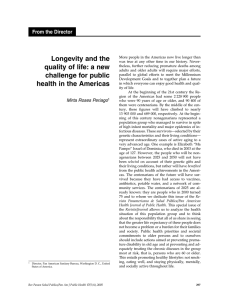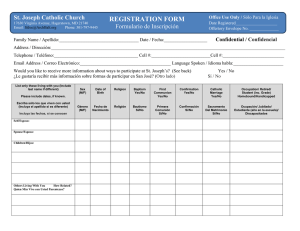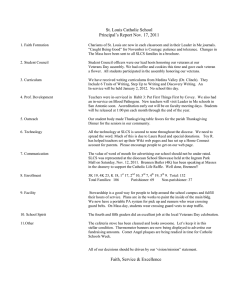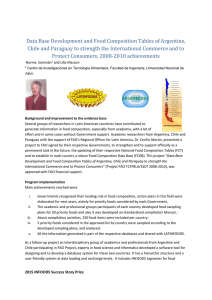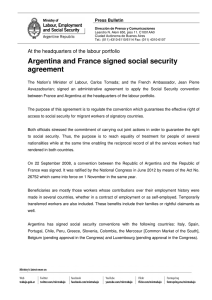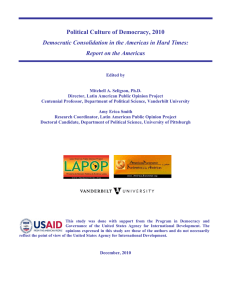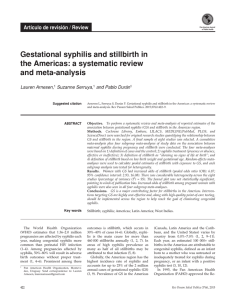English Link - Vanderbilt University
Anuncio
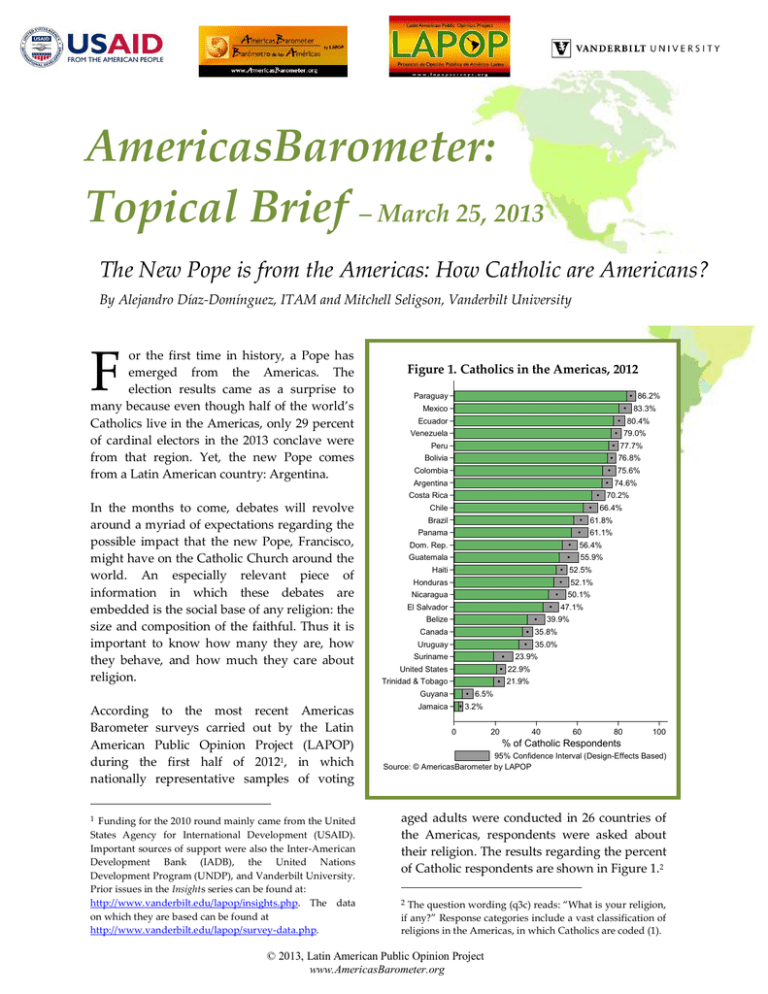
AmericasBarometer: Topical Brief – March 25, 2013 The New Pope is from the Americas: How Catholic are Americans? By Alejandro Díaz-Domínguez, ITAM and Mitchell Seligson, Vanderbilt University F or the first time in history, a Pope has emerged from the Americas. The election results came as a surprise to many because even though half of the world’s Catholics live in the Americas, only 29 percent of cardinal electors in the 2013 conclave were from that region. Yet, the new Pope comes from a Latin American country: Argentina. Figure 1. Catholics in the Americas, 2012 Paraguay 86.2% Mexico 83.3% Ecuador 80.4% Venezuela 79.0% Peru 77.7% Bolivia 76.8% Colombia 75.6% Argentina 74.6% Costa Rica In the months to come, debates will revolve around a myriad of expectations regarding the possible impact that the new Pope, Francisco, might have on the Catholic Church around the world. An especially relevant piece of information in which these debates are embedded is the social base of any religion: the size and composition of the faithful. Thus it is important to know how many they are, how they behave, and how much they care about religion. 70.2% Chile 66.4% Brazil 61.8% Panama 61.1% Dom. Rep. 56.4% Guatemala 55.9% Haiti 52.5% Honduras 52.1% Nicaragua 50.1% El Salvador 47.1% Belize 39.9% Canada 35.8% Uruguay 35.0% Suriname 23.9% United States 22.9% Trinidad & Tobago 21.9% Guyana According to the most recent Barometer surveys carried out by American Public Opinion Project during the first half of 20121, nationally representative samples 1 Americas the Latin (LAPOP) in which of voting Funding for the 2010 round mainly came from the United States Agency for International Development (USAID). Important sources of support were also the Inter-American Development Bank (IADB), the United Nations Development Program (UNDP), and Vanderbilt University. Prior issues in the Insights series can be found at: http://www.vanderbilt.edu/lapop/insights.php. The data on which they are based can be found at http://www.vanderbilt.edu/lapop/survey-data.php. 6.5% Jamaica 3.2% 0 20 40 60 80 100 % of Catholic Respondents 95% Confidence Interval (Design-Effects Based) Source: © AmericasBarometer by LAPOP aged adults were conducted in 26 countries of the Americas, respondents were asked about their religion. The results regarding the percent of Catholic respondents are shown in Figure 1.2 The question wording (q3c) reads: “What is your religion, if any?” Response categories include a vast classification of religions in the Americas, in which Catholics are coded (1). 2 © 2013, Latin American Public Opinion Project www.AmericasBarometer.org The traditional overwhelmingly Catholic countries (at the national level) score at the top, such as Paraguay, Mexico, Ecuador, Venezuela, Peru and Colombia, whereas practically all the English speaking countries score near the bottom: Jamaica, Guyana, Trinidad and Tobago, the US, and Suriname. It is noteworthy that more than three quarters of Argentineans, the Pope’s fellow countrymen and women, report identifying as Catholic, a figure that sharply contrasts with specific religious behaviors as we will show in the following graphs. Figure 2. Catholic Attendance in the Americas, 2012 Guatemala 72.6% Haiti 70.2% El Salvador 64.7% Honduras 60.4% Nicaragua 58.9% Guyana 57.1% Colombia 56.3% Belize 56.2% Bolivia 55.9% Costa Rica 54.3% Dom. Rep. 54.2% Brazil Church attendance can indicate how deeply felt religious identification is in behavioral terms. The newly elected Pope comes from a country in which, as we have shown, most people are Catholic, but as we show here, few actually attend Church on a regular level. Levels of church attendance among Catholics across the Americas vary sharply from country to country, as shown in Figure 2.3 53.9% Ecuador 52.2% Panama 51.9% Mexico 51.7% Jamaica 51.4% Paraguay 50.8% Trinidad & Tobago 49.6% Peru 46.2% Venezuela 37.0% Chile 29.2% Argentina 28.0% Uruguay 16.8% 0 20 40 60 80 Church Attendance Central American Catholics are likely to attend mass almost every week, whereas Catholics from the three well-known religiously liberal South American nations, Chile, Uruguay and Argentina go to mass less than once a month on average (the respondents in the US and Canada were not asked this question). 95% Confidence Interval (Design-Effects Based) Source: © AmericasBarometer by LAPOP Another important religious attitude refers to the link between parishioners and their communities, giving us a measure of “religious social capital,” such as levels of attendance in religious groups, as shown in Figure 3.4 The question wording (q5a) reads: “How often do you attend religious services?”. Response categories are more than once per week, once per week, once a month, once or twice a year, and never or almost never. 3 The question wording (cp6) reads: “I am going to read a list of groups and organizations. Please tell me if you attend their meetings at least once a week, once or twice a month, once or twice a year, or never: meetings of any religious organization? Do you attend them... 4 © 2013, Latin American Public Opinion Project www.AmericasBarometer.org Figure 3. Catholic Attendance Religious Groups, 2012 Guatemala 67.3% Honduras 62.0% El Salvador 60.7% Haiti 60.1% Paraguay 55.2% Dom. Rep. 54.7% Nicaragua 50.3% Brazil 49.6% Colombia 49.5% Jamaica Church attendance however suggests a different scenario, in which all things equal, on average Catholics go to church less frequently when compared to non-Catholics. Similar behavior is reported for participation in religious groups, as shown in Figure 5. Overall, however, Catholics in the Americas are more likely to score higher when talking about how important religion is in their lives, when compared to non-Catholics. 48.7% Trinidad & Tobago 48.0% Bolivia 46.6% Mexico These pieces of evidence mainly suggest a spiritual continent, one now captivated with the first Pope from the region. 42.0% Peru 41.4% Costa Rica 41.0% Ecuador 40.8% Belize 38.9% Guyana 35.9% Panama 35.6% United States 33.6% Venezuela 33.4% Chile 23.9% Argentina Figure 4. Importance of Religion, Catholics, 2012. 22.3% Canada 19.4% Uruguay 14.9% 0 20 40 60 80 Religious Groups 95% Confidence Interval (Design-Effects Based) Source: © AmericasBarometer by LAPOP El Salvador 92.7% Guatemala 90.4% Dom. Rep. 87.0% Nicaragua 86.3% Panama 85.8% Jamaica 85.2% Paraguay 84.8% Guyana Once again, the Pope’s native Argentina scores near the bottom of the list. Central American Catholics score far higher. How much Catholics in the Americas care about religion also varies, as shown in Figure 4,5 in which levels of importance of religion in the lives of the Catholic respondents is shown. Interestingly, although the US is typically considered as a very religious country, it ranks low in comparison to countries in Latin America and the Caribbean. Argentina is near the bottom. Central American countries again score at the top. 84.4% Honduras 83.9% Colombia 82.1% Brazil 81.2% Haiti 80.7% Costa Rica 80.6% Ecuador 79.7% Bolivia 79.5% Belize 79.2% Peru 78.1% Venezuela 73.3% Trinidad & Tobago 72.1% Mexico 70.6% Chile 64.3% Argentina 61.0% United States 60.0% Canada 45.8% Uruguay 44.0% 0 20 40 60 80 100 Importance of Religion 95% Confidence Interval (Design-Effects Based) Source: © AmericasBarometer by LAPOP The question wording (q5b) reads: “Please, could you tell me how important is religion in your life?”. Response categories are very important, rather important, not very important, and not at all important. 5 © 2013, Latin American Public Opinion Project www.AmericasBarometer.org Figure 5. Religious Attitudes in the Americas, 2012 Importance of Religion Catholic 80.0 Other 73.9 Church Attendance Catholic 50.5 Other 54.1 Religious Groups Catholic 42.6 Other 45.2 0 20 40 60 80 95% Confidence Interval (Design-Effect Based) Source: © AmericasBarometer by LAPOP Alejandro Díaz-Domínguez is a doctoral candidate in the Department of Political Science at Vanderbilt University, and Lecturer at the ITAM in Mexico City. He can be reached at [email protected] Dr. Mitchell A. Seligson is Director of the Latin American Public Opinion Project (LAPOP) and Centennial Professor of Political Science at Vanderbilt University. He can be reached at [email protected]. Full results of the 2012 AmericasBarometer and the AmericasBarometer 2012 comparative study can be consulted on-line at www.LapopSurveys.org. The full data set is available for on-line analysis or download (in SPSS and Stata formats) at no cost. © 2013, Latin American Public Opinion Project www.AmericasBarometer.org
